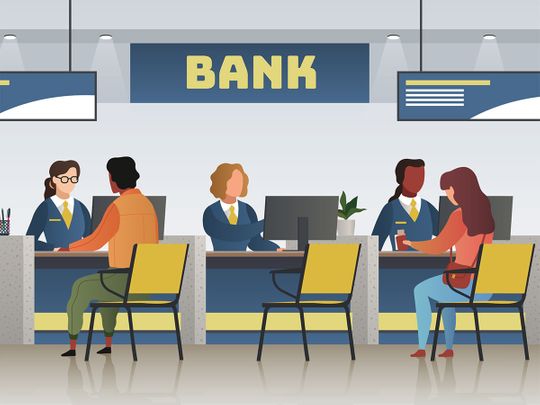
Dubai: Your financial statement often tells a story — at least to a banker. Unfortunately, the tale it tells may be misleading as opposed to your true state of financial health. The more you know what a lender cares about in your bank statements, the better you'll be at making the story they tell a good one.
The reason a lender will need to see your bank statements is to learn more about you as a person and what your spending habits are like. How you have acted lately and the presentation of this on your bank statements can be the difference in how much a lender will let you borrow, if anything at all.
This all comes down to risk. A lender needs to know you’re responsible with your money and can be trusted to handle finances appropriately. For example, a mortgage or home loan is likely the biggest financial commitment you will ever make in your life and is not something to be taken lightly.
Your balance sheet offers a snapshot of what you own (assets) and what you owe (liabilities) on a certain date. So an unusual year-end transactions can paint the wrong picture, and because year-to-year trends are almost as important as the numbers themselves, it's one you'll be stuck with for a long time.
What will lenders be looking for on my bank statement?
So down to the main question. What will lenders actually be looking for? What might flag up in their eyes? For instance, when you apply for a large mortgage or home loan, lenders look at your bank statements to verify that you can afford the down payment, closing costs, and mortgage payments.
Well as mentioned above, they need to know you’re being responsible with your finances. One of the things they’ll be looking at is if there are any overdrafts, which occurs when money is withdrawn in excess of what is on the current account.
Using overdrafts every so often is not necessarily a bad thing, but if you are exceeding your limit on a regular basis, this is going to put your level of trust that pertains to money-related matters into question.
More factors to be careful with are potential bounced cheques, which could show a lender you are not consistently reliable, and not disclosing loans at an application stage, as it won’t look good if the lender finds outgoings on your bank statements that you failed to mention.
Other things to be aware of are missed payments for personal loans and things such as credit cards. If you can prove you handle your money well and are able to meet monthly payment deadlines, a lender will be more likely to lend you an amount closer to that which you would like to borrow.

How far back do lenders look at bank statements in a loan application?
During your loan application process, lenders typically look at two to three months of recent bank statements, if not more. It varies with lenders, but three months of statements are generally enough to gauge risk of lending to you based on our existing financial or spending habits.
You need to also provide bank statements for any accounts holding funds you’ll use to qualify for the loan, including money market (any account that pays interest based on current interest rates), and other salary or savings accounts.
Loan officers use these bank statements to verify your savings and cash flow, check for unusual deposits, withdrawals, or other activity in your accounts, make sure you haven’t taken on any recent debts.
Two to three months’ worth of bank statements is the norm because any credit or deposit accounts older than that should have otherwise shown up on your credit report.
What underwriters look for on your statements when you apply for a loan?
The underwriter — the person who evaluates and approves loan applications — will look for four key things on your bank statements:
• Enough cash saved up for the down payment and closing costs
• The source of your down payment, which must be acceptable under the lender’s guidelines
• Enough cash flow or savings to make monthly loan payments
• Cash reserves, which are extra funds available in case of an emergency
An underwriter generally wants to see that the funds in your bank accounts are yours, and not borrowed from someone else (unless via a properly-documented down payment gift).
In other words, any funds used to qualify for the loan need to be ‘sourced and seasoned’.
’Sourced' means it’s clear where the money came from, and any unusual deposits are explained in writing. Again, large deposits still may require explanation.
’Seasoned' typically means the money has been in your account for at least 60 days. (So the funds should show up on the two or three months’ bank statements you’re required to provide).
Bank statements also prove to underwriters that you haven’t opened up any credit accounts or created new debt prior to getting the loan.

Do lenders look at bank statements before closing your loan application?
Your loan officer will typically not re-check your bank statements right before closing your loan application. Lenders are only required to check when you initially submit your loan application and begin the underwriting approval process.
However, there are a few things your lender will re-check before closing, including:
• Credit score
• Credit report
• Employment and income
You should avoid financing any large purchases or opening new lines of credit (like a credit card) between loan approval and closing.
New debts can affect your credit score as well as your debt-to-income ratio (DTI), which is all your monthly debt payments divided by your monthly income, and this could seriously affect your loan approval and interest rate.
In addition, if anything changes with your income or employment prior to closing, let your lender know immediately. Your loan officer can decide whether any changes to your financial situation will impact your loan approval and help you understand how to proceed.
5 red-flags lenders don’t want to see on bank statements
You might want to take a look at your bank statements with a loan underwriter’s eye before submitting them as part of your loan application. That’s because the lender looks for red flags that, if found, can require lengthy explanations.
Loan underwriters are trained to uncover unacceptable sources of funds, undisclosed debts, and financial mismanagement when examining your bank statements.
Here are five things you can look for on your bank statements that might turn up a red flag for a financial institution.
1. Bounced checks
If your current bank account is littered with multiple overdrafts or NSFs (non-sufficient funds) charges, underwriters are likely to conclude that you’re not great at managing your finances.
Banking experts reveal that additional scrutiny is required when bank statements include NSF fees, while adding that some home loans require lenders to manually re-approve borrowers with NSFs, even if the borrower has already been approved by a computerised system.
2. Large, undocumented deposits
Outsized or irregular bank deposits might indicate that your down payment, required money reserves, or closing costs are coming from an ‘unacceptable’ source - meaning, the funds might be borrowed.
For instance, you could take a cash advance on your credit card, which might not show up on your credit report. A large deposit could also indicate an ‘illegal’ gift – meaning a home buyer can’t take help from a party who stands to gain from the transaction — like the home seller or real estate agent.
Likewise, any recent large deposits without acceptable explanation is most often listed as red flags about which lenders should follow up with the applicant.
If you can’t prove through documentation that the source of a big deposit is acceptable under the bank’s guidelines, the lender must disregard the funds and use whatever is left to qualify you for the loan.
If the verified funds aren’t enough to qualify you for a loan, you’ll need to save another chunk of cash — from an acceptable source.

3. Regular payments, irregular activities
Bankers also watch out for a monthly payment that does not correspond to a credit account disclosed on your application.
Typically, your credit report will pull in your credit cards, auto loans, student loans, and other debt accounts. But some creditors don’t report to the major credit bureaus.
For instance, if you got a private, personal, or business loan from an individual instead of a financial institution, those debt details may not show up on your credit report.
The monthly automatic payment on your bank statement, however, is likely to alert the lender of a non-disclosed credit account.
4. Last-minute purchases
Another common problem that experts see are borrowers who make big purchases after they submit their loan applications but before their loans officially close.
Those new purchases can throw off borrowers' debt-to-income ratios and possibly rush an application that otherwise would have been approved.
Let’s say a borrower has a debt-to-income ratio of 48 per cent, just under that 50 per cent UAE limit. After he or she submits the loan application but before their loan closes, they finance a new car.
That car comes with a monthly auto-loan payment of Dh1,500. That extra Dh1,500 might push their debt-to-income ratios over 50 per cent and into trouble territory.
So before you do anything that you haven't always been doing, anything that breaks your normal pattern of buying and spending, talk to your bank’s relationship manager first. While the bank could give you the go-ahead, but if it is something that will cause issues, the lender needs to know about it.
5. Fluctuating overtime or bonuses
It has been widely observed that loan applicants often would want to flag their bonus or overtime income in their balance statements to boost their chances of getting a larger loan.
However, when it comes to overtime and bonus information, lenders often ask for a bank statement that goes back a couple of years even. This is because if this extra income fluctuates too wildly – high one year, low the next – it could cause problems for borrowers.
For example, one year you might have Dh30,000 worth of yearly overtime. Another, you might have Dh10,000. But lenders can’t use Dh30,000 as the overtime figure you can expect to earn each year.
Say your base salary is Dh50,000 a year, but last year you also made Dh30,000 in overtime. If you only made Dh5,000 worth of overtime the year before, your lender is not permitted to count your qualifying salary as Dh80,000.
Credit experts add that borrowers are often unaware of the multi-year history that goes along with overtime or bonus income.

Key takeaways
There are plenty of reasons underwriters might deny a loan. The two most common are insufficient credit and a high debt-to-income ratio.
When it comes to a home loan or mortgage, lenders need bank statements to make sure you can afford the down payment and closing costs, as well as your monthly mortgage payment. Lenders use all types of documents to verify the amount you have saved and the source of that money.
When underwriters look at your bank statements, they want to see that you have enough money to cover your down payment and closing costs.
Some types of loans require a few months’ worth of payments leftover in the account for emergency cash reserves. In other words, the upfront costs can’t drain your account.
However, bank statements are just one of many factors lenders look at when you apply for a loan. Almost all areas of your personal finances will be under scrutiny; including your credit score and report, your existing debts, and any source of income you’ll use to qualify for the loan.
These factors help determine how much house you can afford (in case of a home loan), your loan amount, and your interest rate. The cleaner your financial situation looks across the board, the better deal you’re likely to get on your new loan or refinance amount.










